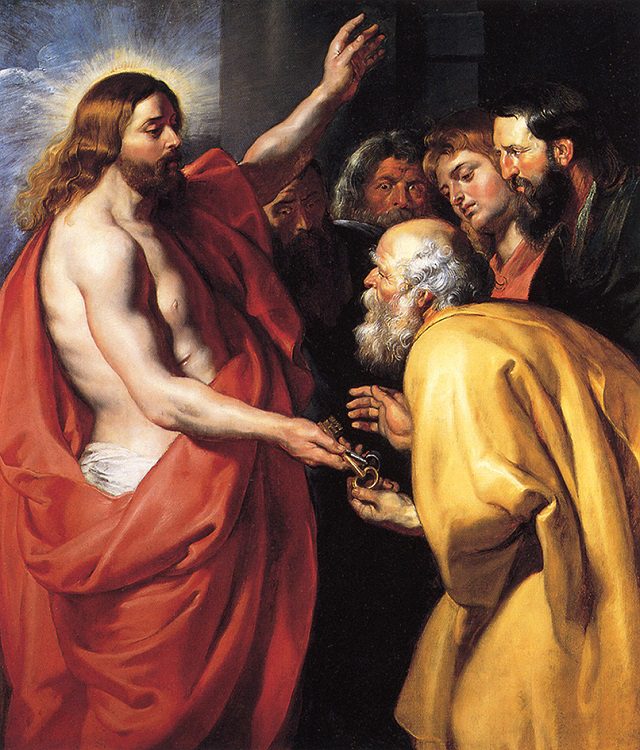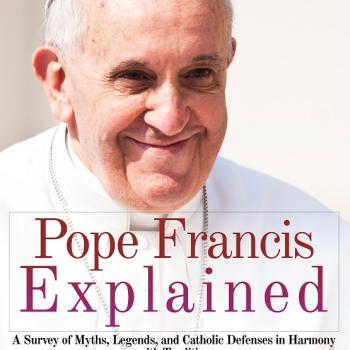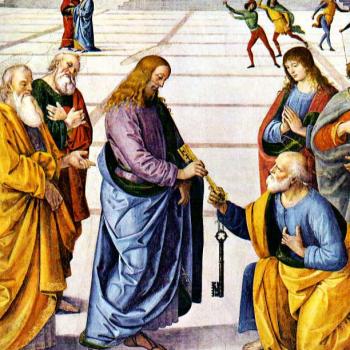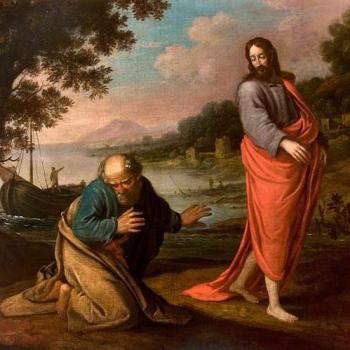
This is one of my many critiques of the book entitled, Roman but Not Catholic: What Remains at Stake 500 Years after the Reformation, by evangelical Protestant theologian Kenneth J. Collins and Anglican philosopher Jerry L. Walls (Grand Rapids, Michigan: Baker Academic, 2017).
*****
Kenneth Collins, in his chapter 11: “The Papacy”, states:
Indeed, the notion that Peter was somehow over the universal church is unfounded. . . .
. . . Matthew 16:18 cannot mean that Peter had authority in an extraordinary way over the other apostles.
Matthew 16:18 (RSV) And I tell you, you are Peter, and on this rock I will build my church, and the powers of death shall not prevail against it.
Collins runs through the standard discussions about whether “the rock” Jesus referred to was Peter’s confession, or he himself. And of course, in the end, he clearly favors the “confession” interpretation because that’s the one that works with Protestant relative ecclesiological disorganization and the denial (of most Protestants) of apostolic succession and episcopal, hierarchical ecclesiology, or Church government.
Yet the position of “rock” in Matthew 16:18 being St. Peter himself (which has been the Catholic view for many centuries) is held by a great number of Protestant exegetes in recent times, including some of the very best ones, and is the majority position (as noted in the Encyclopedia Britannica article on “Peter”: 1985, Micropedia, Vol. 9, 330-333). Collins (bless his heart) does manage to mention one of these: Presbyterian linguist Marvin Vincent. Here are many more that he didn’t mention (lest his readers come to understand that this is virtual consensus in biblical commentary today):
- “Jesus, then, is promising Peter that he is going to build his church on him! I accept this view.” –William Hendriksen, New Testament Commentary: Exposition of the Gospel According to Matthew, (Grand Rapids, MI: Baker, 1973), 647.
- “Nowadays a broad consensus has emerged which–in accordance with the words of the text–applies the promise to Peter as a person. On this point liberal (H. J. Holtzmann, E. Schweiger) and conservative (Cullmann, Flew) theologians agree, as well as representatives of Roman Catholic Exegesis.” –Gerhard Maier, “The Church in the Gospel of Matthew: hermeneutical Analysis of the Current Debate,” trans. Harold H. P. Dressler, in D. A. Carson, ed., Biblical Interpretation and Church Text and Context, (Flemington Markets, NSW: Paternoster Press, 1984), 58.
- “By the words ‘this rock’ Jesus means not himself, nor his teaching, nor God the Father, nor Peter’s confession, but Peter himself.” –J. Knox Chamblin, “Matthew,” in Walter A. Eldwell, ed., Evangelical Commentary on the Bible (Grand Rapids: MI: Baker, 1989), 742.
- “. . . If, then, Mt. 16:18 forces us to assume a formal and material identity between petra and Petros, this shows how fully the apostolate, and in it to a special degree the position of Peter, belongs to and is essentially enclosed within, the revelation of Christ. Petros himself is this petra, not just his faith or his confession.” –Gerhard Friedrich, ed., and Geoffrey W. Bromley, trans. and ed.,Theological Dictionary of the New Testament, vol. VI, (Grand Rapids, MI: Eerdmans, 1968), 98-99.
- “The expression ‘this rock’ almost certainly refers to Peter, following immediately after his name, just as the words following ‘the Christ’ in vs. 16 applied to Jesus. The play on words in the Greek between Peter’s name (Petros) and the word ‘rock’ (petra) makes sense only if Peter is the rock and if Jesus is about to explain the significance of this identification.” –Craig L. Blomberg, The New American Commentary: Matthew, vol. 22, (Nashville: Broadman, 1992), 251-252.
- “The foundation of the messianic community will be Peter, the rock, who is recipient of the revelation and maker of the confession (cf. Eph 2:20). The significant leadership role of Peter is a matter of sober history . . . . [T]he plain sense of the whole statement of Jesus would seem to accord best with the view that the rock on which Jesus builds His Church is Peter.” –William E. McCumber, “Matthew,” in William M. Greathouse and Willard H. Taylor, eds.,Beacon Bible Expositions, vol. 1, (Kansas City, MO: Beacon Hill, 1975), 125.
- “‘You are Rock, and on this Rock I will build my church.’ Peter is here pictured as the foundation of the church.” –M. Eugene Boring, “Matthew,” in Pheme Perkins and others, eds., The New Interpreter’s Bible, vol. 8, (Nashville, TN: Abingdon Press, 1995), 345.
- “Let it be observed that Jesus could not here mean himself by the rock, consistently with the image, because he is the builder. To say, ‘I will build,’ would be a very confused image. The suggestion of some expositors that in saying ‘thou art Peter, and on this rock’ he pointed at himself involves an artificiality which to some minds is repulsive.” –John A. Broadus, Commentary on the Gospel of Matthew, (Valley Forge, PA: Judson Press, 1886), 356.
- “Another interpretation is that the word rock refers to Peter himself. This is the obvious meaning of the passage.” –Albert Barnes, Notes on the New Testament, Robert Fraw, ed., (Grand Rapids, MI: Baker, 1973), 170.
- “It is on Peter himself, the confessor of his Messiahship, that Jesus will build the Church. The disciple becomes, as it were, the foundation stone of the community. Attempts to interpret the ‘rock’ as something other than Peter in person (e.g., his faith, the truth revealed to him) are due to Protestant bias, and introduce to the statement a degree of subtlety which is highly unlikely.” –David Hill, “The Gospel of Matthew,” in Ronald E. Clements and Matthew Black, eds., The New Century Bible Commentary, (London: Marshall, Morgan & Scott, 1972), 261.
- “Some interpreters have therefore referred to Jesus as rock here, but the context is against this. Nor is it likely that Peter’s faith or Peter’s confession is meant. It is undoubtedly Peter himself who is to be the Rock, but Peter confessing, faithful and obedient.” –D. Guthrie and others, The New Bible Commentary, (Grand Rapids, MI: Eerdmans, 1953) [reprinted by Inter-Varsity Press], 837.
- “There is no good reason to think that Jesus switched from petros to petra to show that He was not speaking of the man Peter but of his confession as the foundation of the Church. The words ‘on this rock [petra]; indeed refer to Peter.” –Herman N. Ridderbos, Bible Student’s Commentary: Matthew, (Grand Rapids, MI: Zondervan, 1987), 303.
- “The frequent attempts that have been made, largely in the past, to deny this in favor of the view that the confession itself is the rock (e.g., most recently Caragounis) seem to be largely motivated by Protestant prejudice against a passage that is used by the Roman Catholics to justify the papacy.” –Donald A. Hagner, “Matthew 14-28,” in David A. Hubbard and others, eds., World Biblical Commentary, vol. 33b, (Dallas: Word Books, 1995), 470. (Nicholas Hardesty, “Protestant Scholars on Mt 16:16-19”; 9-4-06)
Here are a few more:
Jesus now sums up Peter’s significance in a name, Peter . . . It describes not so much Peter’s character (he did not prove to be ‘rock-like’ in terms of stability or reliability), but his function, as the foundation-stone of Jesus’ church. The feminine word for ‘rock’, ‘petra’, is necessarily changed to the masculine ‘petros’ (stone) to give a man’s name, but the word-play is unmistakable (and in Aramaic would be even more so, as the same form ‘kepha’ would occur in both places). It is only Protestant overreaction to the Roman Catholic claim . . . that what is here said of Peter applies also to the later bishops of Rome, that has led some to claim that the ‘rock’ here is not Peter at all but the faith which he has just confessed. The word-play, and the whole structure of the passage, demands that this verse is every bit as much Jesus’ declaration about Peter as v.16 was Peter’s declaration about Jesus . . . It is to Peter, not to his confession, that the rock metaphor is applied . . . Peter is to be the foundation-stone of Jesus’ new community . . . (Anglican R. T. France, in Leon Morris, general editor, Tyndale New Testament Commentaries, Leicester, England: Inter-Varsity Press / Grand Rapids, Michigan: Eerdmans Pub. Co., 1985, vol. 1: Matthew, 254, 256)
[I]f it were not for Protestant reactions against extremes of Roman Catholic interpretation, it is doubtful whether many would have taken ‘rock’ to be anything or anyone other than Peter . . . In this passage Jesus is the builder of the church and it would be a strange mixture of metaphors that also sees him within the same clauses as its foundation. . . . Had Matthew wanted to say no more than that Peter was a stone in contrast with Jesus the Rock, the more common word would have been “lithos” (“stone” of almost any size). Then there would have been no pun — and that is just the point! (Baptist D. A. Carson; in Frank E. Gaebelein, general editor, Expositor’s Bible Commentary, Grand Rapids, Michigan: Zondervan, 1984, vol. 8: Matthew, Mark, Luke, 368)
[O]ne must dismiss as confessional any attempt to see this rock as meaning the faith, or the Messianic confession of Peter . . . The general sense of the passage is indisputable . . . Peter is the rock on which the new community will be built, and in that community, Peter’s authority to ‘bind’ or ‘release’ will be a carrying out of decisions made in heaven. His teaching and disciplinary activities will be similarly guided by the Spirit to carry out Heaven’s will. (Methodist William F. Albright and C. S. Mann, Anchor Bible, Garden City, New York: Doubleday, 1971, volume 26, 195, 197-198)
How about St. Peter having extraordinary unique authority as not only the the leader of the apostles, but as the first pope and head of the universal Church (Petrine primacy)? It is not unknown for reputable Protestant scholars to hold to this view (my blue highlighting):
Of those twelve men Simon Peter was the acknowledged leader. There are differences between one evangelist and another in their portrayal of Peter, but on this they are agreed. (F. F. Bruce, Peter, Stephen, James, and John, Grand Rapids, Michigan: Eerdmans, 1979, 16)
[I]t was Peter who became the focal point of unity in the great Church, since Peter was probably in fact and effect the bridge-man who did more than any other to hold together the diversity of first-century Christianity. James and Paul, the two other most prominent leading figures in first-century Christianity, were too much identified with their respective ‘brands’ of Christianity, at least in the eyes of Christians at the opposite end of this particular spectrum . . . none of them, including none of the rest of the twelve, seem to have played any role of continuing significance for the whole sweep of Christianity . . . (James D. G. Dunn, Unity and Diversity in the New Testament, London: SCM Press, 2nd edition, 1990, 385; cited in agreement by Bruce in the work above, pp. 42-43)
So Peter, in T. W. Manson’s words, is to be ‘God’s vicegerent . . . The authority of Peter is an authority to declare what is right and wrong for the Christian community. His decisions will be confirmed by God’ (The Sayings of Jesus, 1954, p. 205). (The New Bible Dictionary, general editor: J. D. Douglas; Grand Rapids, Michigan: Eerdmans Pub. Co., 1962, “Power,” section III: “The Power of the Keys,” by R. N. Caswell, pp. 1017-1018)
“The authority of Peter is to be over the Church, and this authority is represented by the keys.” –S. T. Lachs, A Rabbinic Commentary on the New Testament: The Gospels of Matthew, Mark, and Luke, (Hoboken, NJ: Ktav, 1987), 256.
“And what about the ‘keys of the kingdom’? The keys of a royal or noble establishment were entrusted to the chief steward or majordomo; he carried them on his shoulder in earlier times, and there they served as a badge of the authority entrusted to him. About 700 B.C. an oracle from God announced that this authority in the royal palace in Jerusalem was to be conferred on a man called Eliakim . . . . (Isaiah 22:22). So in the new community which Jesus was about to build, Peter would be, so to speak, chief steward.” –F. F. Bruce, The Hard Sayings of Jesus, (Downers Grove, IL: Intervarsity, 1983), 143-144.
“The ‘kingdom of heaven’ is represented by authoritative teaching, the promulgation of authoritative Halakha that lets heaven’s power rule in earthly things . . . . Peter’s role as holder of the keys is fulfilled now, on earth, as chief teacher of the church.” –M. Eugene Boring, “Matthew,” in Pheme Perkins and others, eds., The New Interpreter’s Bible, vol. 8, (Nashville, TN: Abingdon Press, 1995), 346.
I summarized the ample biblical evidences of Peter’s primacy in my paper, 50 New Testament Proofs for Peter’s Primacy & the Papacy [+ reply to an anti-Catholic critique of it]. This was further condensed and concisely rearranged for a National Catholic Register article. I’ve also dealt with the old non sequitur chestnut of contra-papal polemics (briefly alluded to by Collins): Paul’s rebuke of Peter (for hypocrisy; not doctrinal error). And I tackled the question of papal succession, and made a biblical case for that.
Matthew 16:19 I will give you the keys of the kingdom of heaven, and whatever you bind on earth shall be bound in heaven, and whatever you loose on earth shall be loosed in heaven.
Collins (for good reason, given his goals) completely ignores the Hebraic historical and thematic background of this passage — which goes back to Isaiah 22 –, and all of the implications thereof, which have been massively dealt with by many Protestant commentators. I think folks ought to become acquainted with that fascinating data (rather than be completely in the dark), so here are many more related citations from Protestant scholars (thanks again to Nicholas Hardesty and his article, cited above):
- “The keys are the symbol of authority, and Roland de Vaux (Ancient Israel, tr. by John McHugh [New York: McGraw-Hill, 1961], 129 ff.) rightly sees here the same authority as that vested in the vizier, the master of the house, the chamberlain of the royal household in ancient Israel.” –W. F. Albright and C. S. Mann, The Anchor Bible: Matthew, (Garden City, NY: Doubleday, 1971), 196.
- “The image of keys (plural) perhaps suggests not so much the porter, who controls admission to the house, as the steward, who regulates its administration (Is 22:22, in conjunction with 22:15). The issue then is not that of admission to the church (which is not what the kingdom of heaven means; see pp. 45-47) but an authority derived from a delegation of God’s sovereignty.” –Craig S. Keener, The IVP Bible Background Commentary New Testament, (Downer’s Grove, IL: Intervarsity Press, 1993), 256.
- “The keeper of the keys has authority within the house as administrator and teacher (cf. Isa 22:20-25, which may have influenced Matthew here). The language of binding and loosing is rabbinic terminology for authoritative teaching, for having the authority to interpret the Torah and apply it to particular cases, declaring what is permitted and what is not permitted. Jesus, who has taught with authority (7:29) and has given his authority to his disciples (10:1,8 ) here gives his primary disciple the authority to teach in his name.” –M. Eugene Boring, “Matthew,” in Pheme Perkins and others, eds., The New Interpreter’s Bible, vol. 8, (Nashville, TN: Abingdon Press, 1995), 346.
- “The keys of the kingdom would be committed to the chief steward in the royal household and with them goes plenary authority.” –George Buttrick and others, eds., The Interpreter’s Bible, (New York: Abingdon, 1951), 453.
- “What do the expressions ‘bind’ and ‘loose’ signify? According to Rabbinical usage two explanations are equally possible: ‘prohibit’ and ‘permit’, that is, ‘establish rules’; or ‘put under the ban’ and ‘acquit.'” –Oscar Cullman, Peter: Disciple, Apostle, Martyr, trans. Floyd V. Filson, (Philadelphia: Westminster, 1953), 204-205.
- “These terms [binding and loosing] thus refer to a teaching function, and more specifically one of making halakhic pronouncements [i.e., relative to laws not written down in the Jewish Scriptures but based on an oral interpretation of them] which are to be ‘binding’ on the people of God. In that case, Peter’s ‘power of the keys’ declared in [Matthew] 16:19 is not so much that of the doorkeeper, who decides who may or may not be admitted to the kingdom of heaven, but that of the steward . . . . whose keys of office enable him to regulate the affairs of the household.” –R. T. France, Matthew: Evangelist and Teacher, (Grand Rapids, MI: Zondervan, 1989), 247.
- “In other words, Peter would give decisions, based on the teachings of Jesus, which would be bound in heaven; that is, honored by God.” –Ralph Earle, “Matthew,” in A. F. Harper and others, eds., Beacon Bible Commentary, vol. 6, (Kansas City, MO: Beacon Hill, 1964), 156.
- “This verse [Mat 16:19] therefore probably refers primarily to a legislative authority in the church.” –Craig S. Keener, The IVP Bible Background Commentary New Testament, (Downer’s Grove, IL: Intervarsity Press, 1993), 90.
- “Hence handing over the keys implies appointment to full authority. He who has the keys has on the one side control, e.g., over the council chamber or treasury, cf. Mt. 13:52, and on the other the power to allow or forbid entry, cf. Rev. 3:7.” –J. Jeremias, “Kleis,” in Gerhard Kittel, ed., and Geoffrey W. Bromley, trans. and ed., Theological Dictionary of the New Testament, vol. 3, (Grand Rapids, MI: Eerdmans, 1968), 749-750.
- Particularly note-worthy are the words of Martin Luther in his tract called “The Keys,” which he wrote 9 years after his excommunication:
- “So we stand there and with open mouth stare heavenward and invent still other keys. Yet Christ says very clearly in Mat. 16:19 that he will give the keys to Peter. He does not say he has two kinds of keys, but he gives to Peter the keys he himself has and no others.” –Martin Luther, “The Keys,” in Conrad Bergendoff, ed., trans. Earl Beyer and Conrad Bergendoff, Luther’s Works, vol. 40, (Philadelphia: Fortress, 1958), 365-366.
- “Isaiah 22:15 ff. undoubtedly lies behind this [Mat 16:19] saying.” –W. F. Albright and C. S. Mann, The Anchor Bible: Matthew, (Garden City, NY: Doubleday, 1971), 196.
- “The keeper of the keys was one of the most important roles a household servant could hold (Mark 13:32-34). A higher official held the keys in a royal kingdom (Is 22:22) and in God’s house, the temple.” –Craig S. Keener, The IVP Bible Background Commentary New Testament, (Downer’s Grove, IL: Intervarsity Press, 1993), 90.
- “‘The keys of the kingdom of heaven: the phrase [from Mat 16:19] is almost certainly based on Is. 22:22 where Shebna the steward is displaced by Eliakim and his authority transferred to him.” –D. Guthrie and others, The New Bible Commentary, (Grand Rapids, MI: Eerdmans, 1953) [reprinted by Intervarsity Press], 837.
- “The master of the palace had similar functions at the court of Judah. Announcing the promotion of Elyaqim, Isaiah 22:22 says: ‘I lay the key of the house of David upon his shoulder, if he opens, none will shut; if he shuts, none will open.’ The Egyptian vizier’s instructions are described in a very similar fashion. Every morning ‘the vizier will send someone to open the gates of the kings house, to admit those who have to enter, and to send out those who have to go out.’ One is reminded of the Lord’s words to Peter, the Vizier of the Kingdom of Heaven (Matthew 16:19).” –Roland de Vaux, Ancient Israel, trans. John McHugh (New York: McGraw-Hill, 1961), 130.
- “In Isa 22:22 the key of the house of David is promised to Eliakim. According to Paul, Jesus is the only foundation (1 Cor 3:11), and in Rev 1:18; 3:7, Jesus possesses the key of David and the keys of death and Hades. But in this passage [Matthew 16:19] Peter is made the foundation (cf. Eph 2:20, where the Christian apostles and prophets are the foundation and Christ is the cornerstone) and holds the keys.” –George Buttrick and others, eds.,The Interpreter’s Bible, (New York: Abingdom, 1951), 453.
- “In Matthew 16:19 it is presupposed that Christ is the master of the house, who has the keys to the Kingdom of Heaven, with which to open to those who come in. Just as in Isaiah 22:22 the Lord lays the keys of the house of David on the shoulders of his servant Eliakim, so Jesus commits to Peter the keys of his house, the Kingdom of Heaven, and thereby installs him as administrator of the house.” –Oscar Cullman, Peter: Disciple, Apostle, Martyr, trans. Floyd V. Filson, (Philadelphia: Westminster, 1953), 203.
- “Materially, then, the keys of the kingdom of God are not different from the key of David. This is confirmed by the fact that in Mt. 16:19, as in Rev. 3:7, Jesus is the One who controls them.” –J. Jeremias, “Kleis,” in Gerhard Kittel, ed., and Geoffrey W. Bromley, trans. and ed.,Theological Dictionary of the New Testament, vol. 3, (Grand Rapids, MI: Eerdmans, 1968), 749-750.
- R. T. France, in his commentary on Mat. 16:19 says that Isaiah 22:22 is “generally regarded as the Old Testament background to the metaphor of keys here. . . .” –R. T. France, Matthew: Evangelist and Teacher, (Grand Rapids, MI: Zondervan, 1989), 247.
Bottom line in this discussion: If one wants to simply bask in centuries of contra- and anti-Catholic polemics and bias, and repeat and memorize and chant those, parrot-like, one can (it’s a free country). But if one is interested in the latest consensus of biblical commentary, and in the background of key passages in the New Testament with regard to Church government, then they have to dig a little deeper, and seriously delve into the endless riches of the Bible and Hebrew Old Testament culture and ways of thinking. I did the latter; Collins clearly did not.
Because of that fact, I’m fully confident that the fair-minded, open-minded reader, who is truly interested in all that the Bible has to say, in its depths (not in mere “surfacey” hyper-selective prooftexting; ignoring mountains of relevant data), will see that the purely biblical case for the primacy of St. Peter and even for the essential kernels of the later fully developed papacy (before we even get to Church history), is surprisingly strong (and some might say, compelling).
***
Photo credit: Christ Surrendering the Keys to St. Peter (c. 1614), by Peter Paul Rubens (1577-1640) [public domain / Wikimedia Commons]
***













